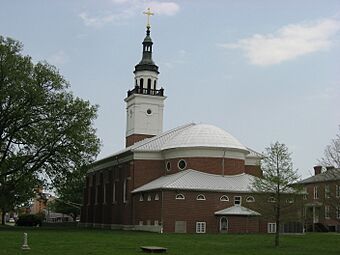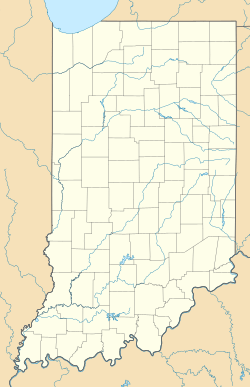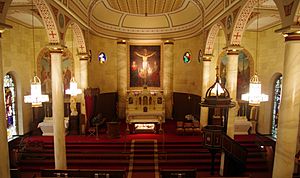St. Francis Xavier Cathedral and Library facts for kids
Quick facts for kids |
|
|
Old Cathedral Complex
|
|
|
U.S. Historic district
Contributing property |
|

The cathedral from the rear.
|
|
| Location | 205 Church St., Vincennes, Indiana |
|---|---|
| Area | 2 acres (0.81 ha) |
| Built | 1826 |
| Architectural style | Greek Revival |
| NRHP reference No. | 76000025 |
| Added to NRHP | 17 August 1976 |
The St. Francis Xavier Cathedral is a very old and important Catholic church in Vincennes, Indiana. People also call it the Basilica of St. Francis Xavier or simply "The Old Cathedral." It is part of the Diocese of Evansville.
This church is named after Francis Xavier, a famous Jesuit missionary from the 1500s. You can find it across from the George Rogers Clark National Historical Park at 205 Church Street. It's located inside the Vincennes Historic District.
Jesuit missionaries started the St. Francis Xavier church around 1734. The King of France gave them the land. This makes it the oldest Catholic church in Indiana! Its first records of baptisms and marriages are from 1749.
The church building you see today was built in 1826. It has a style called Greek Revival. It stands on or near where two older Catholic churches used to be.
In 1834, Pope Gregory XVI created the Diocese of Vincennes. A diocese is an area managed by a bishop. St. Francis Xavier then became a cathedral, which is the main church for a bishop. It was the bishop's main church from 1834 to 1898.
On March 14, 1970, Pope Paul VI gave St. Francis Xavier Cathedral a special title: minor basilica. This honor is only given to very historic and important churches.
Between 1834 and 1898, two priests from St. Francis Xavier became bishops. Many others became important church leaders. From 1837 to 1882, seventy-five priests were ordained here. Michael E. Shawe was the first priest ever ordained in Indiana.
Bishop John Stephen Bazin became a bishop at St. Francis Xavier in 1847. This was the first time a bishop was made in Indiana. The first four Bishops of Vincennes are buried in a special room called a crypt under the church. The basilica was added to the National Register of Historic Places in 1976.
Contents
A Long History of Faith
The story of St. Francis Xavier church is closely connected to how the Catholic Church grew in Indiana. This church has links to six different Catholic dioceses across North America.
It started as an early Jesuit mission in the 1700s. Later, in the 1800s, it became the main church for the Diocese of Vincennes. In 1970, it received its special title as a basilica.
Early Jesuit Mission (1732–1763)
St. Francis Xavier is the oldest Catholic church in Indiana. Its beginnings go back to early Jesuit missionaries. They visited the area along the Wabash River as early as 1732.
Vincennes was named after a Canadian soldier, François-Marie Bissot, Sieur de Vincennes. This place became an important French trading post and military spot in the Northwest Territory.
The first priest to live at St. Francis Xavier was Father Sebastian Louis Meurin. He arrived in May 1748. The oldest church record is a marriage from April 21, 1749. The first baptism was recorded on June 25, 1749.
In December 1750, Madam Trattier, who was the first to be married in the church, died at age eighteen. She was buried under her pew in the first church building.
After 1763, the Jesuits were told to leave the area. Father Duvernay, a priest there, left Vincennes. But the Diocese of Quebec still had religious control over St. Francis Xavier church.
A Parish Church (1763–1834)
Between 1763 and 1785, St. Francis Xavier church did not have a priest living there. During this time, a public official performed baptisms.
In 1770, the people of Vincennes asked for a priest. The Bishop of Quebec sent Father Pierre Gibault to visit. Father Gibault returned during the American Revolutionary War. He had the French people of Vincennes promise loyalty to the Americans in 1788.
On February 25, 1779, British General Henry Hamilton gave up Fort Sackville to Colonel George Rogers Clark. This happened at St. Francis Xavier church.
In 1785, Father Gibault came back to Vincennes. He was the first priest to live there in over twenty years. He left in 1789, and no priests lived there again until 1792.
On November 6, 1789, Pope Pius VI created the Diocese of Baltimore. This was the first Catholic diocese in the United States. St. Francis Xavier church became part of this new diocese.
John Carroll, the first Bishop of Baltimore, sent Father Benedict Joseph Flaget to Vincennes. Father Flaget arrived on December 21, 1792. He started a school at the church before he was called back to Baltimore in 1795.
Father Jean François (John Francis) Rivet replaced Father Flaget. He started a college, which later became Vincennes University. He taught classes in the church's rectory. He died in 1804, leaving the church without a priest again.
In September 1808, Father Flaget became the first bishop of the Diocese of Bardstown. St. Francis Xavier church then became part of this new diocese. In 1814, Bishop Flaget was the first Catholic bishop to visit Indiana.
Visiting priests continued to serve St. Francis Xavier until 1818. Then, Fathers Blanc and Jeanjean became resident priests. In 1823, Father Leo Champomier became the resident priest. In 1825, Bishop Flaget asked Father Champomier to build a new brick church. This became the St. Francis Xavier Basilica we see today.
Becoming a Cathedral (1834–1898)
On May 6, 1834, Pope Gregory XVI officially created the Diocese of Vincennes. This was the first Catholic diocese in Indiana. St. Francis Xavier became the main church, or cathedral, for this new diocese. It was the bishop's church for all five Bishops of Vincennes.
Father Simon Bruté de Rémur became the first Bishop of Vincennes on October 28, 1834. He died in Vincennes in 1839.
Father Célestin de la Hailandière became the second Bishop of Vincennes in 1839. He resigned in 1847. During his time, the part of the Diocese of Vincennes in Illinois became the Diocese of Chicago in 1843.
When Rev. John Stephen Bazin became the third Bishop of Vincennes in 1847, it was the first time a Catholic bishop was made in Indiana. Bishop Bazin died in 1848.
Father Jacques Maurice de St. Palais became the fourth Bishop of Vincennes in 1849. He served until his death in 1877. In 1857, the northern part of Indiana became the Diocese of Fort Wayne.
Rev. Francis Silas Chatard was the fifth and last Bishop of Vincennes. He became bishop in 1878. However, he chose Indianapolis, the state capital, as the new main city for the bishop.
Between 1837 and 1882, seventy-five priests were ordained at St. Francis Xavier. This included Michael E. Shawe, the first priest ordained in Indiana. In 1898, the bishop's main office moved to Indianapolis. Bishop Chatard became its first bishop.
Modern History (Since 1898)
St. Francis Xavier remained under the Diocese of Indianapolis from 1898 to 1944. In 1944, Pope Pius XII made the Diocese of Indianapolis an Archdiocese. He also created two new dioceses in Indiana: the Diocese of Evansville and the Diocese of Lafayette.
On March 14, 1970, Pope Paul VI gave St. Francis Xavier Cathedral the special title of a basilica.
Building the Cathedral
The St. Francis Xavier Basilica we see today was built in 1826. It is the oldest Catholic church building in Indiana. It was built on or near the spot of two earlier churches.
The first chapel was a simple building made of logs, mud, and a bark roof. It was built around 1734. A second log church replaced it in 1785. It was larger and had a small bell tower. The first church was then used as a rectory, where the priests lived.
On July 24, 1825, Father Jean Leon Champomier held a meeting. He suggested building a new brick church, which became the current basilica. Its first stone was laid on March 30, 1826. A big storm in November 1826 destroyed two walls of the unfinished church. But it was rebuilt. The first services were held in the new church in the summer of 1827. The inside was not yet finished or decorated.
When Bishop Bruté, the first Bishop of Vincennes, arrived in 1834, the church was still not complete. Bishop Hailandière, the second bishop, continued the work. In April 1840, the south end of the church collapsed, but it was rebuilt. Bishop Hailandière officially dedicated the cathedral on August 8, 1841.
Bede O'Connor, a church leader for Bishop St. Palais, oversaw the inside decoration. Father Hugo Peythieu brought fourteen oil paintings from France for the Stations of the Cross.
Cathedral Library
A small brick building next to the church was built in 1840. It became known as the Old Cathedral Library. It held Bishop Bruté's personal collection of over 5,000 books and papers. His collection became the start of the cathedral's library. This was the first library in Indiana.
In 1968, a grant helped build a new museum and library. This new building holds the collection, which has grown to over 11,000 rare books. The oldest document is a papal paper from Pope John XXII from 1319. It is hand-engraved on parchment.
What the Cathedral Looks Like
The basilica is the main building in a group of structures. This group also includes a rectory (built 1841), the old library (1840), a newer library/museum building (1968), and a cemetery.
Outside and Layout
The basilica is built in a simple Greek Revival style. It is made of reddish-orange bricks. Its design is similar to the St. Joseph Cathedral in Bardstown, Kentucky.
St. Francis Xavier is 115 feet long and 60 feet wide. Each side has five windows. The front has a window above each of its three entrance doors.
In 1834, Bishop Bruté described the unfinished church as a plain brick building. It had no plaster or paint inside. It had a simple wooden altar, a gold tabernacle, a cross, and six candlesticks. After he arrived, the roof was made stronger. The inside walls were plastered. A sacristy (a room for priests to prepare) was added.
The sanctuary (the holy area) was later made larger. Its floor was raised to make space for a burial crypt underneath. Bishop Hailandière also added a ciborium (a canopy over the altar), a new main altar with saints' relics, and side altars. Other changes included stone steps at the front, a larger organ area, and a new organ. More changes were made in 1908 (new windows and brick supports) and 1911 (some upper windows were closed).
A bell tower was added in the 1830s. It was designed by architect Jean Marie Marsile. The bell in the tower is very old, from around 1742. It used to hang in the parish's first church.
Statues of St. Joan of Arc, St. Francis Xavier, and St. Patrick stand in special arched spots on the front of the cathedral. A statue of Father Pierre Gibault is in front of the cathedral. It honors his help to the Americans during the American Revolutionary War.
Inside the Church
Wilhelm Lamprecht (1838–1922) was an artist who studied in Germany. He came to America to paint and decorated churches in New Jersey, Ohio, and Vincennes.
Lamprecht painted three large murals for St. Francis Xavier in 1870:
- A Crucifixion scene above the main altar.
- A Madonna (Mary) with the patron saints of the first four bishops of Vincennes. This is above the Blessed Mother altar.
- Saint Francis Xavier, the church's patron saint, above the Saint Joseph altar.
The fourteen oil paintings for the Stations of the Cross were brought from France around 1883. Their frames were carved locally.
Von Gerichten Art Glass Company made the stained glass windows in 1908. They show Saints Matthew, Mark, Luke, and John.
Large Doric columns hold up the church's arched ceiling. They are made of yellow poplar wood covered in plaster and painted to look like marble.
Church Services and Visits
St. Francis Xavier church is part of the Diocese of Evansville.
As of August 2025, Mass is held on Sunday evenings. It is also held on Tuesday mornings (during the school year), Wednesday evenings, and Friday at noon. Confession is available on Friday mornings and Sunday evenings.
The basilica's library and museum are open from Memorial Day through Labor Day. They are open Monday through Saturday afternoons, or by appointment.
The Bishops of Vincennes
Five bishops led the Diocese of Vincennes after St. Francis Xavier became a cathedral in 1841.
- Simon Bruté de Rémur (Bishop from 1834 until his death in 1839)
- Célestine de la Hailandière (Bishop from 1839 until he resigned in 1847)
- John Stephen Bazin (Bishop from 1847 until his death in 1848)
- Jacques Maurice de St. Palais (Bishop from 1849 until his death in 1877)
- Francis Silas Chatard (Bishop from 1878 until his death in 1918). Bishop Chatard became the first Bishop of Indianapolis in 1898 when the main church office moved there.
The first four Bishops of Vincennes are buried in the crypt under St. Francis Xavier. Bishop Chatard was buried in Indianapolis.
Images for kids
See also
 In Spanish: Catedral de San Francisco Javier (Vincennes) para niños
In Spanish: Catedral de San Francisco Javier (Vincennes) para niños
- List of Catholic cathedrals in the United States
- List of cathedrals in the United States
- Oldest churches in the United States






